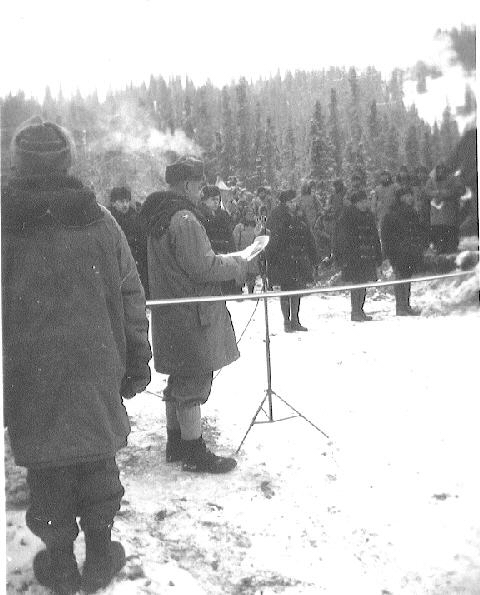Soldier’s Summit
Soldier’s Summit is associated with one historic theme of relevance to the Alaska Highway Corridor nomination:
♦ Engineering achievement and North American strategic cooperation
Description of the Site
Soldier’s Summit is located at km 1650.8 (historic milepost 1061) on the Alaska Highway, within Kluane National Park and Reserve and the traditional territory of Champagne and Aishihik, Kluane, and White River First Nations. The interpretive display, opened in 1992, is reached by a 1 km walking trail. The trailhead is located at the Tachäl Dhäl (Sheep Mountain) Visitor Centre. The site offers vistas of Kluane Lake and part of the Slims River delta. At one point the visitor can see four different versions of the Alaska Highway: the original tote road, the military road in place by the 1942 opening, the re-routed highway along Kluane Lake, and the new Shakwak Project highway which was completed in 2008.
History
This site commemorates a ceremony that took place on 20 November 1942. The occasion was the culmination of nearly a year of accelerated construction resulting in the completion of the initial “pioneer road” from Dawson Creek, BC to Alaska, an estimated distance of 2,454 km (1,525 miles).
The Alaska Highway was built in sections by seven US Army regiments moving north from Dawson Creek, south from Delta Junction in Alaska, east and west from Whitehorse, and east from Teslin (after reaching the community by boat) toward Watson Lake. Consequently there were a few places where the builders linked up, most notably Contact Creek where northbound soldiers of the 35th Regiment met members of the 340th at historic milepost 585; and Beaver Creek near the Alaska-Yukon border, the meeting place of the 97th and 18th Engineers on 28 October 1942. It was decided, however, that the opening ceremonies should take place at a scenic overlook, later christened Soldier’s Summit, by Kluane Lake.
 November was a cold time to hold a ceremony
November was a cold time to hold a ceremony
Credit: South Peace Historical Society, Resource ID 13681.
It was a quickly organized event with much wartime pomp and ceremony. Attendees included members of the Canadian and American military, RCMP officers in red serge, Alaskan and Canadian government representatives, and other dignitaries. Two African American soldiers and two White soldiers held the ribbon, which was cut by Ian Mackenzie, the Canadian Minister of Health, and E. L. Bartlett, Secretary of State for Alaska. A US Army brass band played both national anthems then the first truck convoy headed north. Afterwards a festive dinner featured local moose, sheep and even a “thinned-out bear.”
The significance of the Soldier’s Summit ceremony was recognized in a few ways. The two halves of the pair of scissors used to cut the ribbon were donated to Prime Minister Mackenzie King and President Franklin Roosevelt, each bearing a plaque of Alaskan gold engraved by Juneau jeweller George Osborne. Small pieces of the red, white and blue ribbon were affixed to commemorative cards and given out as mementos, some of which are now in museum collections.
On 18 July 1992, Parks Canada hosted a ceremony marking the opening of the historic walking trail and unveiling of the Historic Sites and Monuments Board plaque. The plaque commemorates the building of the Alaska Highway in three languages (English, French, and Southern Tutchone). First Nations communities were consulted, and suggested edits to the wording of the plaque as well as inclusion of the Southern Tutchone text. After a year of events commemorating the building of the highway, on 20 November 1992, there was a re-creation of the original ceremony at Soldier’s Summit.
Existing Heritage Recognition
In 1979, World Heritage status was proclaimed for Kluane National Park and Reserve and Wrangell-St. Elias National Park and Preserve. This was expanded to become the largest international site recognized by UNESCO with the addition of Glacier Bay National Park and Preserve in 1992 and Tatshenshini-Alsek Park in 1994.

